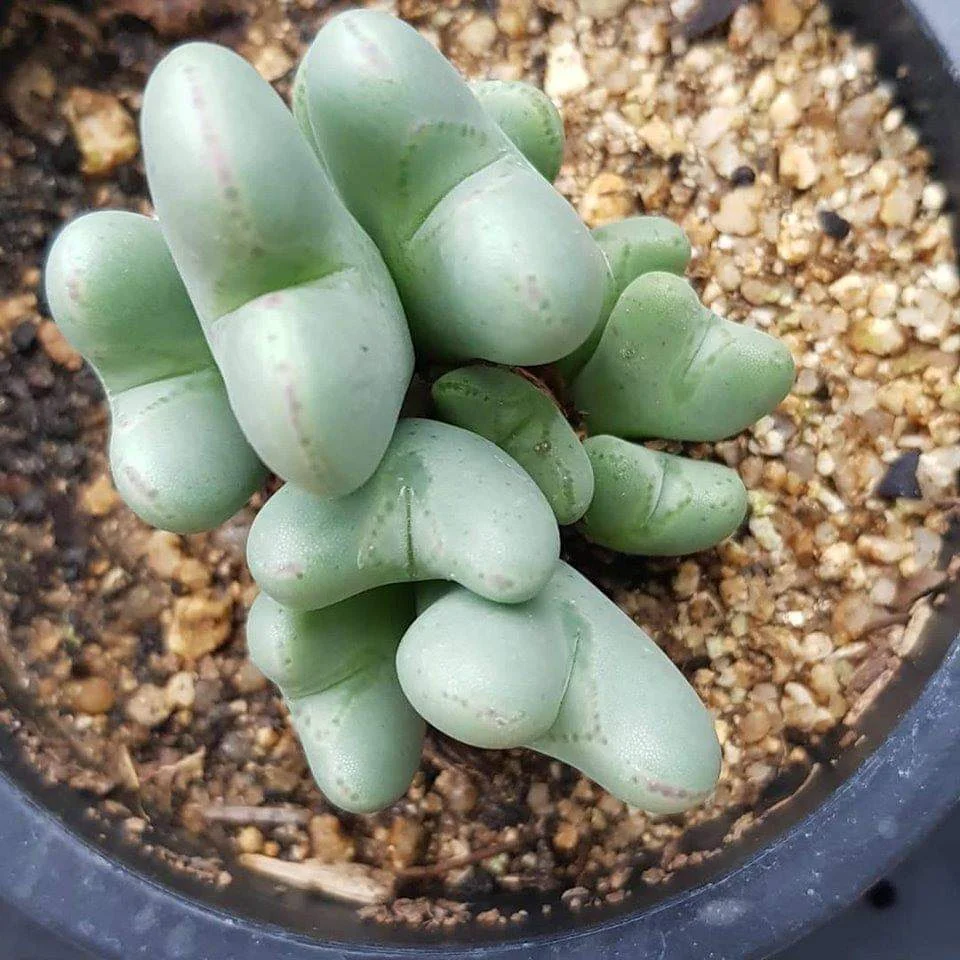Conophytum bilobum - 10 seeds


Conophytum bilobum - 10 seeds
Conophytum bilobum is a small, stemless (or with short stems with time) succulent up to 3 inches (7.5 cm) tall, with paired leaves up to 1.2 inches (3 cm) wide. The surface is slightly harsh to the touch, chalky-green and dotted with darker green. The leaf-tips are free in profile, triangular in shape and keeled. The margins and tops of the lobes are green and often with a reddish or deep purple line. The flowers are diurnal, bright yellow to red-orange, up to 1 inch (2.5 cm) in diameter and appear in fall (rarely in summer).
1. Sterilize substrate (3+ minutes in microwave or 50 mins in oven- (350°F) and let it cool)
2. Mesembs (Lithops, Conophytums...) require a well draining soil, which means it dries out quickly. Soil should contain a lot of pumice, perlite or sand. Sand should consist of many sizes of particles, from dust to 1/8”. The basic soil mix is 1 soil mix to 3 pumice and sand. Remove any big chunks (peat) from the potting soil.
3. Planters should be about 1-1.5 inches deep. Fill a container with good draining soil. Leave 1/2 inches to the top free. Press the substrate, equally.
4. Disperse pebbles granulated up to 0.2 inches
5. You can sow 50 -100 seeds into one planter 3x3 inches. Mesemb seeds are very tiny.
6. Equally Water the substrate with water (boil and then let it cool) - place a piece of a napkin on top of the substrate and slowly pour the water over it.
7. Let the container soak up water for 5 minutes. Leave the container to drain out the water surplus.
8. Mix some fine sand to the bag with seeds, and sprinkle contents of the bag onto the substrate and pebbles. Do not cover with too much soil or the seeds may not germinate.
9. Put the whole container into a zip bag to keep humidity.
10. Avoid exposing to direct sunlight, but provide them light on some bright place, temperature should be about 77°F.
11. The germination process usually starts within 4-7 days but some seeds can germinate after month or two. Don't expect all the seed to germinate at the same time.
12. Start opening the container gradually so that the seedlings can get used to the new air conditions. Remove bag completely after a month.
13. Seedlings need some moisture, substrate shouldn’t be dry, but don’t overwater. and they need an ample amount of light – but not direct sunlight! you need to take care of them constantly next 3-5 months.
14. Repot them when you notice that seedlings are space-limited, which is usually in a year.
15. Buy only seeds from reputable sources like www.rareplant.me. That way you will avoid scams, fake or bad seeds, and you will always get fresh ones.
The Conophytums belonging to the Ophthalmophyllum group are some of the world's most fascinating plants and are sought by the collector of succulent plants. They grow on winter rain and heads for summer dormancy. They are notoriously difficult to grow because they rot very easily. Paying attention to the particular growing requirement of Ophthalmophyllum is especially important. If you provide the Ophthalmophyllum with the right conditions, they will reward you with their unique shape, size, colour and a proliferation of blooms in autumn. However, Ophthalmophyllum are tricky plants that are very particular about their growing conditions and require the right maintenance in order to keep happy. But don't be afraid even the best growers have plants that mysteriously dry up, or leave during the night. While Ophthalmophyllum are picky about their care, if you are patient and remember the basics, your efforts will be rewarded. Being small plants, a representative collection can be grown on a patio table, a sunny windowsill or a shelf in the greenhouse. The growing season in northern hemisphere is from September to March. Soil: It grows best in sandy-gritty soil and requires good drainage as it it is prone to root rot. It can grows outdoor in sunny, dry, rock crevices (protection against winter wet is required) It can also be cultivated in alpine house, in poor, drained soil. Repotting: Repotting every year is not recommended. They may stay in the same pot for many years. Plants grown in larger containers have frequently relatively poor flowers. They might improve when the plants are given their own, small individual pots. Fertilization: Feed it once during the growing season with a fertilizer specifically formulated for cactus and succulents (poor in nitrogen), including all micro nutrients and trace elements diluted to ½ the strength recommended on the label. It thrives in poor soils and need a limited supplies of fertilizer to avoid the plants developing excess vegetation, which is easily attacked by fungal diseases. Watering: The Ophthalmophyllum thrive in dry and desert regions and are able to stand extended periods of drought and require careful watering. Water minimally in summer, (only occasional misting), water more abundantly after the previous year's leaves have dried up when they are growing in the autumn and spring, but let the soil dry between soaking. Requires little water otherwise its epidermis breaks (resulting in unsightly scars). If grown in a container, bottom watering by immersing the container is recommended. Ensure a very good ventilation. Light: It enjoy some shade (avoid direct sun as it grows wild among rocks and under the shade of other plants) and in summer it need to be kept in a cool area. Hardiness: It prefer a very bright situation and require a minimum temperature 5°C (But will take a light frost and is hardy down to -7° C for short periods if it is in dry soil). USDA zones 9A – 11.
